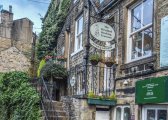The Wrinkled Stocking article mentions the word 'lease' a lot. Does that mean one is not able to buy and own the place outright? That it must be leased from someone else like a renter?
I may be wrongly thinking about this as a house, that one may want to own, which has been converted into a business. Instead of a building that one may not want to own which was meant for business.
One of the British members can answer this much more knowledgeably than I can, but I'll take a stab at it based on what I learned from reading Virginia Woolf's diaries and letters.
Much of the land in Great Britain is owned by people, often titled families, going back into the mists of history. They lease it for building residences and businesses, often using 100-year leases. The landowners sometimes own the buildings, as well, or the land can be leased for others to build on. In the latter case, the buildings can be leased or rented out by those who built them.
For instance, the Duke of Bedford owned (maybe still owns) quite of lot of the land and the buildings on it in Bloomsbury (London). Leonard and Virginia Woolf leased a house in a Georgian terrace at the south end of Tavistock Square, using the lower ground floor for their publishing business, Hogarth Press, sub-letting the ground floor to a solicitor, and living on the remaining floors. Sometime after the start of World War II, the rumor went around that the Duke was planning to knock down the terrace in order to build another hotel. So much residential property in London had already been bombed that if the Woolfs were to relocate within London, it was best to do it immediately, rather than waiting for the Duke to evict them. They leased a smaller place on Mecklenburgh Square, moving the Hogarth Press out of London to Letchworth and put a manager in charge of the press. The solicitors office moved with them, subletting the ground floor.
Not long afterward, the Luftwaffe bombed the terrace on Tavistock Square, saving the Duke the expense of demolishing it. After the war, he built another of his nondescript-looking hotels on the property. When in London, I stay in one of the LSE residence halls while classes are not in session so it operates as a B&B. It's in a similar Georgian terrace about a block away from the Woolfs former home. Because I know from old photos how the former terrace looked, the hotel seems like a blight on the square.
To get back to the original topic, given the layout of the cafe and the history of Holmfirth, the building probably was originally a residence with the rent set to attract low-paid mill workers. It may have been divided down the middle, like Nora's cottage is, so that the entrance from Huddersfield Road led into a different dwelling than the entrance off Scarfold did.





